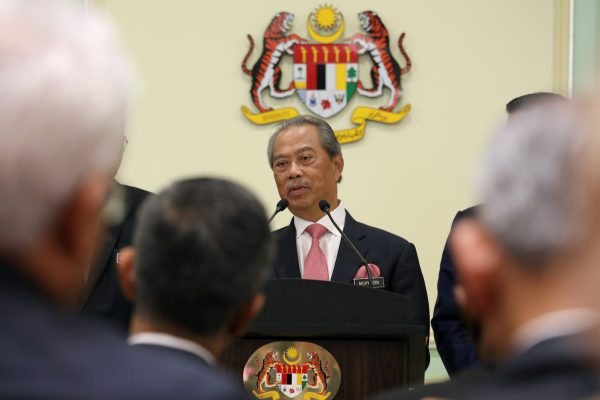Malaysia’s next federal election must be held by September 2023, but there have been calls for fresh elections since last February when PH imploded under twin strains: the power struggle between then prime minister Mahathir Mohamad, his promised heir Anwar Ibrahim, and Anwar’s rival Azmin Ali; and the smear campaign by PAS and BN’s anchor party, the United Malays National Organisation (UMNO), that portrayed the PH government as betraying Malay-Muslims.
The withdrawal from PH in February 2020 of 26 MPs under Muhyiddin’s Malaysian United Indigenous Party (Bersatu) and 10 others from Anwar’s People Justice Party (PKR), led by Azmin Ali, saw Malaysia’s first non-UMNO-led federal government replaced by Malaysia’s first unelected coalition government, PN. Ironically, UMNO and Bersatu — itself home to 15 ex-UMNO parliamentarians — soon started fighting each other over the allocation of future ministerial posts and constituencies. While accompanied by some minor parties, PN has now effectively been reduced to a pact between Bersatu and PAS.
Muhyiddin now holds a fragile parliamentary majority — 113 out of 220 MPs. His survival hinges on two things: the inability of his opponents to agree on his replacement and the COVID-19 pandemic. Anwar’s several attempts to court UMNO parliamentarians to support him for the premiership have failed. In the absence of an alternative prime minister, Muhyiddin’s collapse would kick off fresh elections, a prospect relished by UMNO but feared by Malaysia’s King after a snap state election in September 2020 spurred Malaysia’s third wave of COVID-19 infections.
In January, the King consented to Muhyiddin’s request for Emergency Proclamation and the suspension of parliament and elections until 1 August. Malaysia’s daily per capita COVID-19 cases have now exceeded India. Some accuse Muhyiddin of exploiting the circumstances to prolong the emergency until 2023.
A prolonged parliamentary suspension allows Muhyiddin to freely formulate policies and spend government funds. While the government’s incoherent policies and double standards on the enforcement of lockdowns have invited public backlash, widespread opposition to the emergency has not emerged. UMNO’s 38 MPs are divided over when they should pull the plug on Muhyiddin — while two backbenchers pulled out in January, 16 ministers and deputy ministers are not keen to quit.
Between 2008–2015, Malaysian politics was organised into two multiethnic coalitions — BN and PH’s forerunner Pakatan Rakyat — modelled roughly on the British two-party system. Yet the two-coalition project pursued by BN’s opponents since 1990 seems all but dead as both the government and opposition fragment.
On the opposition front, Anwar’s PKR has been weakened by continuous defections of its lawmakers to Bersatu. Two Mahathir proteges, the former Sabah chief minister Shafie Apdal and ex-youth minister Syed Saddiq, are joining hands, and their candidates may rival PKR’s.
In the 2018 elections, PH and Shafie’s Sabah Heritage Party (Warisan) won power with 48 per cent of the popular vote as the majority split between BN (34 per cent) and PAS (17 per cent). Yet the next federal election promises to be even more fragmented.
The East Malaysian battlefields will likely adhere to the two-bloc format. In Sarawak, the Sarawak Parties Alliance (GPS) will face off against PH. In Sabah, the Sabah People’s Coalition (GRS) — containing both UMNO and Bersatu — will take on Warisan and PH. Conscious of their kingmaker status, GPS, GRS and Warisan will likely align en bloc with the highest bidder.
The ultimate battlefield will be in the 78 Malay heartland constituencies and 66 demographically mixed constituencies across West Malaysia. In 2018, 55 Malay heartland constituencies returned no majority winners in the three-way race between BN, PAS and PH. If Bersatu can crush UMNO, it would be a victory for incumbency over party loyalties. In the mixed constituencies, PH’s prospects may depend on non-Malay voter turnout and whether PAS completely supports Bersatu all out and splits UMNO/BN’s Malay vote.
Ultimately, the next government will involve an alliance between the rival party coalitions — PN, BN and PH — that is augmented by support from the East Malaysian parties. There are four possible formations: PH-BN-East Malaysians, BN-PH-East Malaysians, BN-PN-East Malaysians and PN-BN-East Malaysians.
With automatic voter registration and a lowering of the voting age to 18 expected to be implemented in 2021, a later election would mean an electorate that is younger, more ethnically Malay and more unpredictable. While the delay will give parties more time to excite unenthusiastic voters, it will give other voters time to judge those parties that fail to capture the public’s imagination.
Chin Huat Wong is Professor in the Jeffrey Sachs Center of Sustainable Development and the Jeffrey Cheah Institute on Southeast Asia (JCI) at Sunway University.

